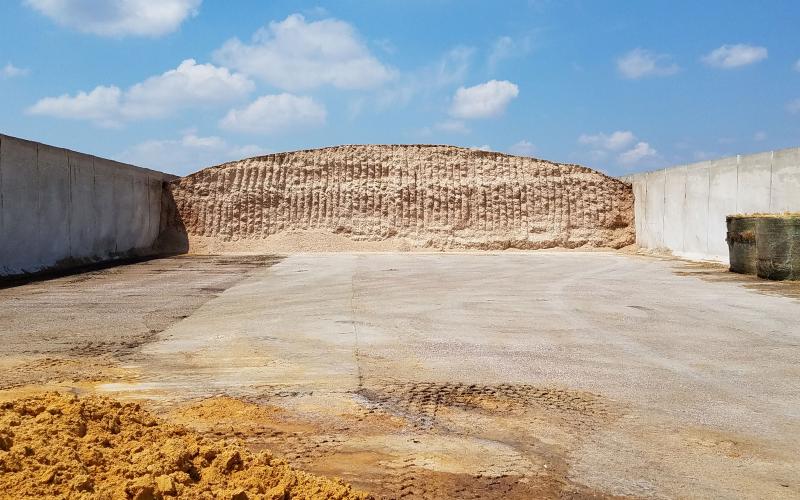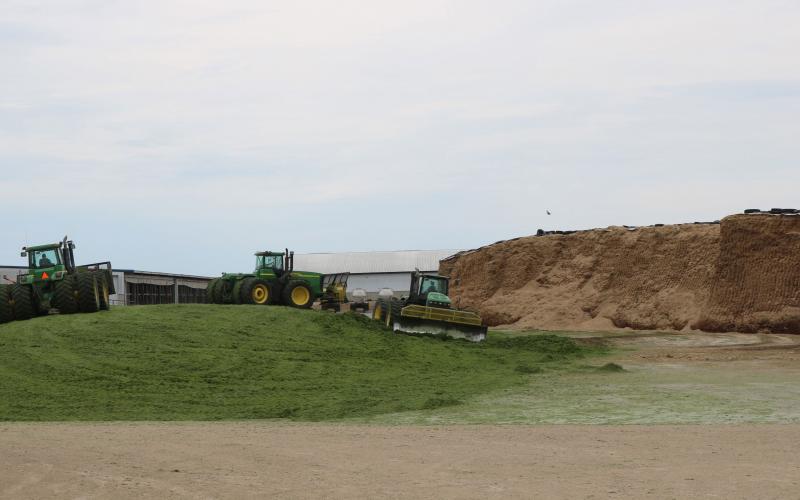Producers who raise both corn and cattle have the option of harvesting some or all of their corn acres as a high-moisture grain crop to be marketed through cattle. There are several advantages to harvesting corn earlier at a high-moisture content including:
- Avoiding drying costs.
- Earlier harvest window helps spreads out workload and allows for earlier residue grazing or harvest.
- Reduced risk of adverse weather in late fall/winter months.
- Reduced pre-harvest field losses (3 to 6%).
- Improved palatability high similar feed values compared to dry corn.
Cattle feeders do need to carefully manage the harvest and storage process in order to preserve as much feed value as possible and optimize their returns.
High-Moisture Corn
Harvesting at the correct moisture content is the first and arguably the most critical factor in managing high-moisture corn. The optimal moisture content ranges from 28-34 percent. Harvesting at drier than optimal results in reduced starch digestibility and increased risk of spoilage. Crop conditions can change quickly, so growers need to be prepared to fill storage facilities rapidly or be able to switch fields as conditions change.
Bacterial inoculants should be considered with high-moisture corn, especially if harvest delays occur or moisture contents are at the lower end of the acceptability range. Cooler temperatures in the fall can compromise some of the viability of naturally occurring bacteria and high-moisture corn has lower levels of sugars compared to traditional corn silage to promote rapid fermentation. Inoculants containing Lactobacillus buchneri strains have been shown to be beneficial to help insure successful fermentation. Inoculants containing L. buchneri have been shown to help reduce heating when the bunker or bag face is exposed to air during feedout.
High-moisture corn that will be stored in a bunker or bag should be processed through either a roller mill or hammer mill prior to storage. Processed corn can be packed more readily which facilitates the exclusion of oxygen. Rolling generally produces less fines and consequently less risk of acidosis. Bunkers need to be packed thoroughly so as to exclude oxygen and covered with plastic to minimize spoilage. Whole high moisture corn can be stored in oxygen-limiting upright silos.
Earlage
Earlage offers unique opportunities to cattle feeders. Because the feed contains both grain and roughage, it can often be fed instead of a combination of corn with hay, straw, or silage roughage sources. Doing so simplifies feed inventory and reduces the opportunities for errors in feed weighing and mixing.
The same general principles discussed with high-moisture corn apply to earlage. Optimal moisture content will be high compared to shelled corn (35 to 40%) with harvest below those values increasing risk of spoilage. The harvest equipment needs to be set so that the cob portion is broken so that no pieces are larger than a thumb nail and so no long leaf/husk strands remain in the captured product stream. Failure to do so could result in voids within the bunker or pile and increased risk of mold growth or heating.
Other Management Considerations
Feeding high-moisture feeds offers a number of opportunities to capture efficiencies in an integrated livestock/crops system. Before adopting these practices, there are some factors that need to be considered.
- Harvesting corn as high-moisture feeds removes marketing options other than as ruminant feed.
- Additional equipment such as a roller mill or pile facing equipment may need to be purchased.
- Harvesting too dry can be a recipe for disaster and that window can close quickly. Producers need to have sufficient labor and equipment available and be ready to alter plans to adapt to changing conditions.
- Using multiple smaller bunkers or piles to minimize the face surface exposure may be preferable to a single larger pile, especially if planning to feed high-moisture feeds in the summer months.


